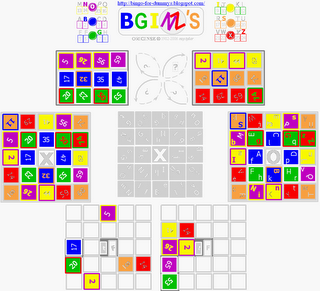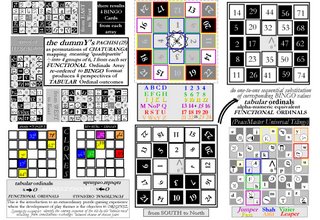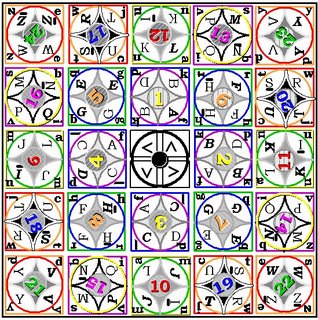

The essential definition is the initial 5 x 5 grid which shows the analogous 'Chaturanga' pre-cursor of Chess moves of the different pieces from (X) center: S)hah, V)izier, F)ers, A)lfil, and the split symmetry of the Chess knight into 2 sets J)umper and L)eaper,
The second grid is the ordinal naming of the geometric dislplacement sets, an ideal mapping of alphabet 'Pachisi' alpha-numeric ordinals , the third is the perfect conventional BINGO array with 12 bold 'fixed' and 12 limited optional BC; EF&GH; JK; RS&TU; and the fourth grid is its corresponding "tabular" synchronicity.
The use of the alphabet is critical to understanding the system. The original concept of BOINxGSz requires the creation of the dummies by exchanging values, Right Side 'dummy' : tabular to FUNCTIONAL ( FUNCTIONAL from tabular) as well as the Left Side 'DUMMY': tabular from FUNCTIONAL ( FUNCTIONAL to tabular)
Substitutions are from an initial card of BINGO values, in other words between the [UPPER] case 3rd grid and the [lower] case 4th grid. The first level challenge puzzle: Given each dummy as a pair - can the 'source Bingo board be re-integrated? This is surprisingly simple, yet somehow elusive and tricky, the potential for error is considerable.
We have then the results showing each "dummy": one created from TABLE to GROUP (white values on black background) and its correlate from TABLE to GROUP (white on black) as "binary" tiles, a duality "duel" (hence du'e'lity). The first level objective is find the original BINGO board from which the binary tiling was derived -facilitated by the two composite board clues. This is only the beginning of a fascinating exploration....
Each dummy will now have new properties, but the RS dummy has the same alphabetical code - now if the same transmutation is continued a kind of Binary tree results. Intuitively I presume eventually it will be like a 'Mobius grid': everything will permutate back to source board...
(actually the LS dummy of first RS operation is in fact the source board - a similar result for RHS dummy of first LS operation does not.....)
The next phase is the random distribution of the integers 1 through 24, then assigning their numeric ALPHA designations from the 4 cardinal points of view: some will be in place - others will require either necessary or the 50/50 choices.The subtle factor remains that the assignment of the alphabetical functional sets can be permutated,in turn the tabulars once synchronized will permit the one to one substitution of BINGO numbers(or for that matter any distinct number groups, shapes, symbols, images,(words?, or even concepts?)
I have elaborated a system which extrapolates a particular type of Magic square - which has a specific relationship to certain underlying geometric principles. Hint: the 5x5 grid projects to a 9x9 grid with an inclusive even 8x8 grid. In turn there is a remarkable recursive property which is where the true gaming potential begins. One of the implied double 'entendres' in my choice of Bingo for Dummy's is that in a certain context rules of play are for Dummies e.g. the rules of Chess actually limit the potential of its concept - since simultaneous play is not possible!
Given that BINGO obviously DOES NOT require a manual to play; the need for a manual would imply that there is a body of data / detail to assist the player in taking up the challenge of creative/explorative play. There are some initial "puzzles" to be learned so as to enable further play - with the ultimate objective being to determine playable themes. The chief game potential to date lays the foundation for a simultaneous play game for 2 to 24 players, although this could also be seen in terms of 'n' players....
It consists of determining the scoring sequence from a random selection of one value from each distinct functional set - e.g VARIEM representing sets Vwyz Abcd Rstu Ijkl Efgh Mnpq - the choice of permutation left to players. From the represenation of the classic BINGO array the respective tabulars would be [ e - f - c - a - g - b ]This starting chain can now be extended into the full sequence which then is used as the order of moves, which in turn determines the vacated tile scoring order. This is ultimate challenge - an unusual environment where chance and skill can interface.





